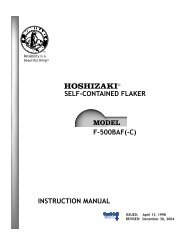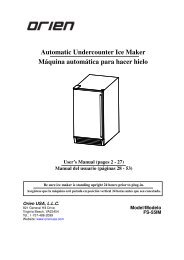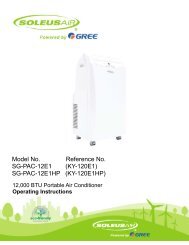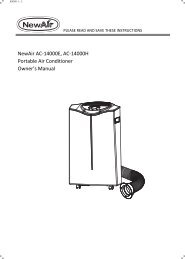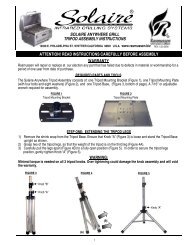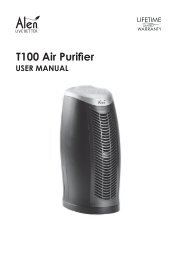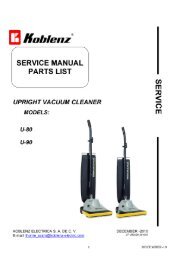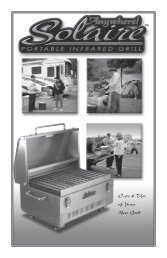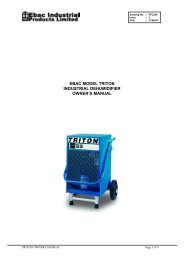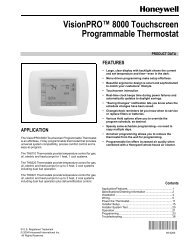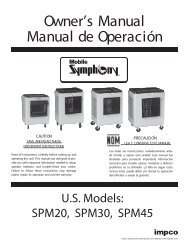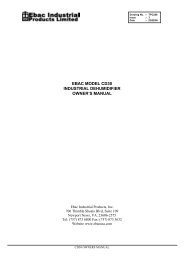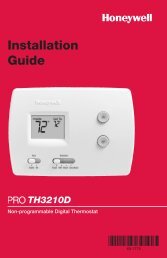68-0133 - Y8610U Intermittent Pilot Retrofit Kit - Air & Water
68-0133 - Y8610U Intermittent Pilot Retrofit Kit - Air & Water
68-0133 - Y8610U Intermittent Pilot Retrofit Kit - Air & Water
You also want an ePaper? Increase the reach of your titles
YUMPU automatically turns print PDFs into web optimized ePapers that Google loves.
STEP 3: Check spark ignition circuit. You need a short jumper wire<br />
made from ignition cable or other heavily insulated wire.<br />
❑ Close the manual gas valve.<br />
❑ Disconnect the ignition cable at the SPARK terminal on the<br />
module.<br />
WARNING<br />
When performing the following steps, do not touch<br />
stripped end of jumper or SPARK terminal. The<br />
ignition circuit generates over 10,000 volts and<br />
electrical shock can result.<br />
❑ Energize the module and immediately touch one end of<br />
the jumper firmly to the GND terminal on the module.<br />
Move the free end of the jumper slowly toward the SPARK<br />
terminal until a spark is established.<br />
❑ Pull the jumper slowly away from the terminal and note the<br />
length of the gap when sparking stops. Check table below.<br />
Arc Length Action<br />
No arc or arc less<br />
than 1/8 in. (3 mm)<br />
Arc 1/8 in. (3 mm) or<br />
longer.<br />
Check external fuse, if provided.<br />
Verify power at module input<br />
terminal. Replace module if fuse<br />
and power are okay.<br />
Voltage output is okay.<br />
STEP 4: Check pilot and main burner lightoff.<br />
❑ Open the manual gas valve.<br />
❑ Set the thermostat to call for heat.<br />
❑ Watch the pilot burner during the ignition sequence to see if:<br />
• ignition spark continues after the pilot is lit;<br />
• pilot lights and the spark stops, but main burner does<br />
not light.<br />
15<br />
<strong>Y8610U</strong> INTERMITTENT PILOT RETROFIT KIT<br />
❑ Ensure adequate flame current as follows:<br />
• Turn off the furnace at the circuit breaker or fuse box.<br />
• Clean the flame rod with an emery cloth.<br />
• Make sure the electrical connections are clean and tight.<br />
Replace damaged wire with moisture-resistant No. 18<br />
wire rated for continuous duty up to 105°C (221°F).<br />
• Check for a cracked ceramic insulator, which can cause<br />
short to ground, and replace the igniter-sensor, if<br />
necessary.<br />
• At the gas control, disconnect the main valve wire from<br />
the TH or MV terminal.<br />
• Turn on the power and set the thermostat to call for<br />
heat. The pilot should light but the main burner remains<br />
off because the main valve actuator is disconnected.<br />
• Check the pilot flame. Make sure it is blue, steady, and<br />
envelops 3/8 to 1/2 in. (10 to 13 mm) of the flame rod.<br />
See Fig. 20 for possible flame problems and their<br />
causes.<br />
• If necessary, adjust the pilot flame by turning the pilot<br />
adjustment screw on the gas control clockwise to<br />
decrease or counterclockwise to increase the pilot<br />
flame. Following adjustment, always replace the pilot<br />
adjustment cover screw and tighten firmly to assure<br />
proper gas control operation.<br />
• Set the thermostat below the room temperature to end<br />
the call for heat.<br />
❑ Recheck ignition sequence as follows:<br />
• Reconnect the main valve wire.<br />
• Set the thermostat to call for heat.<br />
• Watch the ignition sequence at the burner.<br />
• If spark still does not stop after the pilot lights, replace<br />
the ignition module.<br />
• If the main burner does not light or if the main burner<br />
lights but system shuts down, check module, ground<br />
wire, and gas control, as described in the<br />
troubleshooting guide, Fig. 19.<br />
<strong>68</strong>-<strong>0133</strong>—2



